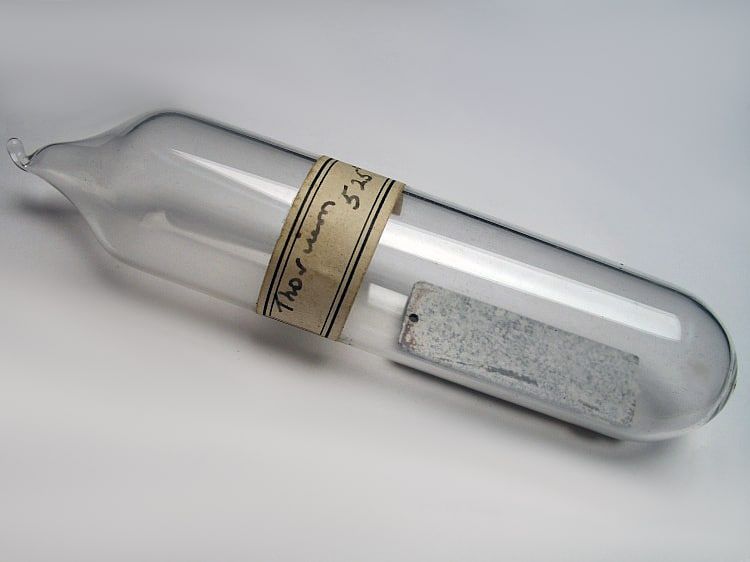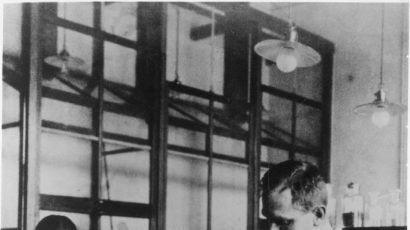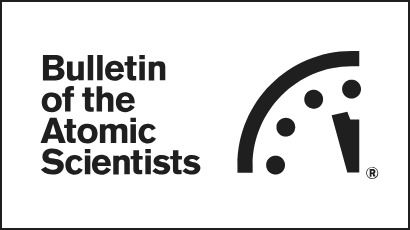Thorium

Greg Webb / IAEA (CC BY-SA 4.0)
Thorium (Th-232) is a silvery-white, slightly-radioactive metal found in nature. It is being studied as part of a fuel solution for thermal nuclear reactors in power plants.
Thorium has no isotopes that readily fission, however, and is incapable of sustaining a nuclear fission chain reaction on its own. Thorium is therefore not usable as a fuel directly. But it has a fertile nucleus that can be converted to uranium-233 (U-233) in a reactor, according to the World Nuclear Association.
“Thorium is like wet wood,” said Ratan Kumar Sinha, former secretary of India’s Department of Atomic Energy. In 2018, Sinha explained to the BBC that wet wood is no good at starting a fire, but once it’s placed in a furnace burning dry wood, it can catch fire.
In 1828, Hans Morten Thrane Esmark, discovered thorite, a mineral that contains thorium, on the Norwegian island of Løvøya. The pastor and amateur mineralogist was out duck hunting when he spotted the crystalized black mineral. Swedish chemist Jöns Jacob Berzelius named the element thorium after Thor, the hammer-wielding Norse god of thunder.
A full thorium-driven fuel cycle that uses uranium-233 for power generation could offer a range of benefits compared to the existing US fleet of nuclear power plants. However, the potential advantages of thorium are relatively small, wrote research scientist Andrew T. Nelson in 2012, when viewed through the lens of economic and political realities. Thorium does not appear to be a “near-term commercial nuclear fuel,” Nelson wrote.
Several scholars have recognized the inherent proliferation risk of protactinium separations in the thorium fuel cycle. When thorium 232 is irradiated, three isotopes of protactinium are produced. Two of these—protactinium 232 and 233—decay to uranium 232 and 233. Further processing could produce material “suitable for making nuclear weapons,” wrote Eva C. Uribe in 2018.
In 2019, Democratic presidential candidate Andrew Yang called thorium “superior to uranium on many levels,” although many of his claims were inaccurate. Specifically, the assertion that thorium reactors would be more economical than traditional uranium reactors is false.
Although thorium is more abundant in nature than uranium, the cost of uranium is a small fraction of the overall cost of nuclear energy. Nuclear energy economics is largely driven by the capital cost of the plant, and building a power plant with a thorium reactor is no cheaper than building a power plant with a uranium reactor. Further, using thorium in existing reactors is technically possible, but it would not provide any clear commercial benefit and would require other new infrastructure.
Jean McSorley, senior consultant for Greenpeace’s anti-nuclear campaign, has been critical of thorium use.
“Even if thorium technology does progress to the point where it might be commercially viable, it will face the same problems as conventional nuclear: It is not renewable or sustainable and cannot effectively connect to smart grids,” McSorley told the Guardian in 2011. “Thorium reactors are no more than a distraction.”
Still, India, Russia, France, China, and the United States are doing research into using thorium as a nuclear fuel. In the United States, large deposits of thorium have been identified in the “Lemhi Pass district of Montana-Idaho and the Wet Mountains area of Colorado.”
The Bulletin of the Atomic Scientists publishes stories about nuclear risk, climate change, and disruptive technologies. The Bulletin also is the nonprofit behind the iconic Doomsday Clock.


